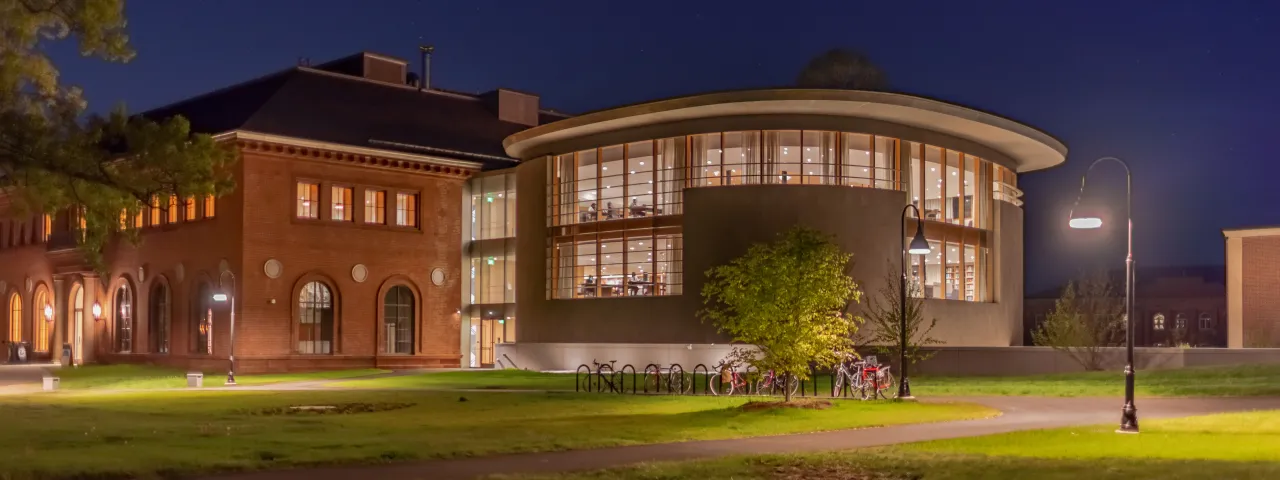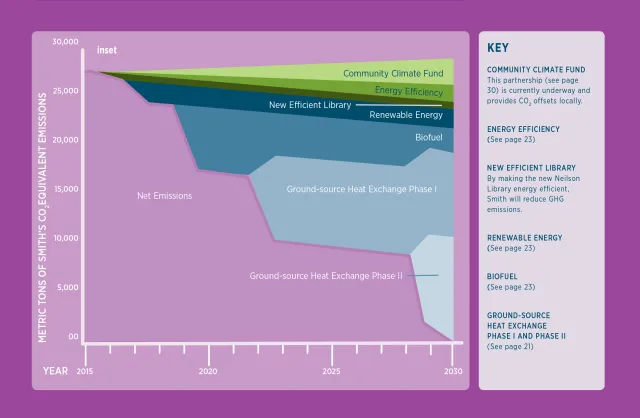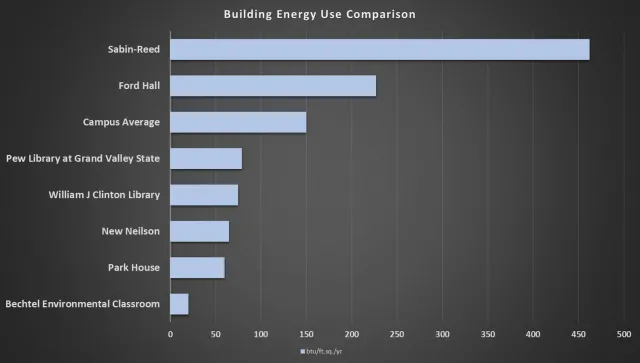
Neilson Library Sustainability Features
Creating a sustainable building was a critical objective in the design and architectural planning process for the new Neilson Library; one that reflects the college’s commitment to sustainability.
Neilson Library Awarded LEED Gold Certification
In March 2022, Neilson Library was awarded LEED Gold certification in Building Design and Construction for New Construction and Major Renovations. From the start Smith wanted the new Neilson Library to be an exceptionally sustainable and environmentally sensitive building. A Sustainability Charter was developed to guide the work, tracking the sustainability goals and referencing requirements throughout the construction. The U.S. Green Building Council which awards LEED (Leadership in Energy and Environmental Design) certifications worldwide uses a complex system of metrics with 110 benchmarks in nine categories before determining the final rating. The categories include sustainability, innovation, materials and resources, indoor environmental quality, water efficiency, energy and atmosphere, regional priority credits and integrative processes. To learn more and see the Neilson Library Scorecard, visit the U.S. Green Building Council website.
This achievement is a tribute to careful planning and preparation, implemented by Smith Facilities, Maya Lin Studio, Shepley Bulfinch Architects, Shawmut Construction, and all the contractors and subcontractors who exceeded the high standards required by the process.
Vision for Sustainability
The vision is inspired by the inherent sustainability of our campus libraries, which have lent millions of items over the decades, avoiding the need for individual books to be printed for each individual library user. A student in the Center for Sustainability discovered that the most circulated book in the Smith Libraries is Calculus: The Language of Change. It was borrowed 972 times in AY ‘15-16. This repeated circulation saved:
- 33 tons of CO2
- 480,168 sheets of paper
- 72 trees
- 68,862 gallons of water
The sustainability vision for the new Neilson Library includes the following components:
- Do something exceptional in the area of sustainability (driven by library use and Smith College identity)
- Create exceptional, healthy, efficient spaces for research & reflection
- Provide a stable environment for sensitive archival items in Special Collections
- Build a smaller, better library (10% reduction in impervious surface on site) and minimize net greenhouse gas emissions (consistent with our campus commitment to carbon neutrality)
- Reuse and rehabilitate key assets (e.g. Alumnae Gym)
- Promote positive environmental behavior & personal responsibility
- Provide ecologically & pedagogically beneficial landscapes
- Minimize operational complexity
Material Reuse
Rather than construct an entirely new building, the college incorporated Neilson's core exterior shell (the original 1909 brickwork), south lower-level foundations and portions of the north retaining walls into the new structure. Soils excavated from the construction site were tested, stored, and reused when applicable. In addition, interior building elements such as wood wall paneling and furniture were saved and will be brought back in for use in the new facility.
An elm tree from the Neilson grounds is also being repurposed for the building project. The tree became unstable during construction and had to be removed; the wood is being transformed into furniture for the new Neilson Library. Woodworker Sam French is fabricating three live edge reading room tables, four live edge benches, and a one-of-a-kind live edge cookie table, all designed by Maya Lin. Live edge furniture is designed to incorporate the natural contours of wood planks; rather than cutting away knots and creating square edges, only the bark is removed.
Healthy Materials
The college committed early on to make the new Neilson Library as healthy as possible for the students, faculty, staff, and visitors who will be using it. Recent studies have found that cognitive function scores were 61 percent higher in green building conditions.
The college has used the Neilson Library project to advocate for positive change in the marketplace, encouraging manufacturers to remove toxic chemicals from production and create a market demand for healthy, innovative products. The team educated and advocated to over 100 manufacturers as a result of this targeted approach.
Manufacturers were also encouraged to eliminate “Red List” chemicals - 22 classes of chemicals found in building materials that are known toxins to humans and the environment. These toxic classes of chemical have become standard in manufacturing. Wherever possible, the new Neilson Library is being constructed without materials on the "Red List." Here are some examples of healthier materials used in the Neilson Library:
- Ceiling tiles that use innovative plant-based acrylic binders in order to remove formaldehyde typically used in these products
- Carpeting is free of PVC (polyvinyl chloride) carpet backing, and the fibers contain no HFRs (halogenated fire retardants) or PFCs (perfluorinated compounds)
- Kitchen & lavatory floors are free of BPA (bisphenol A)
- Cork and rubber flooring are free of formaldehyde, BPA, and PVC
- High pressure laminates were removed from the millwork, and particleboard containing formaldehyde was replaced with Red List Free fiber board
- Doors are Red List Free, and use an agri-fiber core
- Removed Red List chemicals from prefabricated window wall by specifying an anodized aluminum instead of a traditional painted product
The Path to Carbon Neutrality
Smith joined the Climate Leadership Network in 2007 by signing the Carbon Commitment. In doing so, Smith pledged to create a climate action plan that included “a target date for achieving carbon neutrality as soon as possible.” Smith’s Sustainability and Climate Action Management Plan (SCAMP) set a target date of 2030. Carbon neutrality (having no net GHG emissions) can be achieved by minimizing greenhouse gases (GHG) emissions as much as possible and by accounting for the remaining emissions elsewhere. One approach is for institutions to use carbon offsets—a reduction or removal of carbon dioxide equivalent GHG emissions that is used to counterbalance or compensate for emissions from another activity. Campus GHG emissions levels have been reduced by almost 28 percent since our peak emission year of 2004.
On its current trajectory, Smith will not get to carbon neutrality by 2030 without significant changes (see the chart below). By recommitting and refining its approach to carbon neutrality now and working on it over the next decade, Smith can meet the target deadline.

The energy efficiency of the new Neilson Library is one of the elements that will help Smith meet its carbon neutrality goal. The library will be constructed with the goal of being the most energy-efficient library with archival storage in North America. Below is a comparison of building energy use, looking at both bothings owned by Smith, and other libraries in the U.S. (Pew and Clinton libraries).

The building is also aiming for LEED Gold certification. LEED (Leadership in Energy and Environmental Design) is the most widely used green building rating system in the world, and the college is using v4.1 - its most stringent version.
The carbon neutrality information listed here is taken directly from the 2017 Study Group on Climate Change Final Report.
Landscape Design
Native Species and Climate Change
The landscape design surrounding Neilson Library will include exclusively native plant species. The design is “climate forward”; species for which Northampton is at the northern edge of their natural range have been prioritized because they will thrive on our campus even as the climate warms. In addition, tough local plants have been selected for use due to their ability to tolerate extremes in both temperature and precipitation.
Many of the plants were sourced from Native Plant Trust's nursery at Nasami Farm, which aims to grow as much as they can from wild-sourced seed. Unlike most commercial nursery plants, which are typically clonal, the genetic diversity (within species) of this type of production is believed to have more capacity to support the natural, living systems we are connected to and more resilience in the face of climate change.
Maintenance
The landscape is designed to thrive without irrigation, so there won’t be any installed on the grounds surrounding the Neilson Library. The grounds will also feature several acres of low-maintenance lawn alternatives that will require little mowing, and very little water or fertilizer.
Wildlife Habitat
The design and plant materials have been selected not only for aesthetics, but to provide habitat for insects, birds, and other local animals.
Social Equity
The new paths around the library are designed for easy navigation by people of all abilities, and outdoor commons like the amphitheater and restored lawns will encourage dialogue and foster connection.